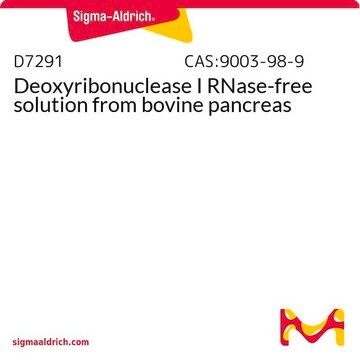D4263
Desoxirribonuclease I
Standardized vial containing 2,000 Kunitz units of DNase I (D4527), vial of ≥0.25 mg total protein
Sinônimo(s):
DNase I, Desoxirribounucleato 5′-oligonucleotídeo-hidrolase
Selecione um tamanho
R$ 489,00
Selecione um tamanho
About This Item
R$ 489,00
Produtos recomendados
fonte biológica
bovine pancreas
Formulário
powder
atividade específica
1700—2300 U/vial
peso molecular
~31 kDa
purificado por
chromatography
embalagem
vial of ≥0.25 mg total protein
técnica(s)
DNA extraction: suitable
solubilidade
0.15 M NaCl: soluble 5.0 mg/mL, clear
adequação
suitable for molecular biology
aplicação(ões)
diagnostic assay manufacturing
diagnostic assay manufacturing
temperatura de armazenamento
−20°C
Procurando produtos similares? Visita Guia de comparação de produtos
Categorias relacionadas
Aplicação
Ações bioquímicas/fisiológicas
Características e benefícios
Versatile applications: This enzyme can be used to nick DNA, incorporate labeled bases into DNA, and isolate and molecularly characterize cancer stem cells in murine breast tumors. It is also useful in comparative studies of deoxyribonuclease isolated from bovine, ovine, and porcine pancreas.
Stable: The enzyme remains active for up to five hours at 60 °C between pH 5 and 7, and can be stored for up to a week at −20 °C with minimal loss of activity. This stability makes it a cost-effective and convenient option.
Definição da unidade
Nota de preparo
Nota de análise
Inibidor
Palavra indicadora
Danger
Frases de perigo
Declarações de precaução
Classificações de perigo
Resp. Sens. 1
Código de classe de armazenamento
11 - Combustible Solids
Classe de risco de água (WGK)
WGK 3
Ponto de fulgor (°F)
Not applicable
Ponto de fulgor (°C)
Not applicable
Equipamento de proteção individual
Eyeshields, Gloves, type N95 (US)
Escolha uma das versões mais recentes:
Certificados de análise (COA)
Não está vendo a versão correta?
Se precisar de uma versão específica, você pode procurar um certificado específico pelo número do lote ou da remessa.
Já possui este produto?
Encontre a documentação dos produtos que você adquiriu recentemente na biblioteca de documentos.
Os clientes também visualizaram
Protocolos
To standardize a procedure for the enzymatic assay of Deoxyribonuclease I.
Active Filters
Nossa equipe de cientistas tem experiência em todas as áreas de pesquisa, incluindo Life Sciences, ciência de materiais, síntese química, cromatografia, química analítica e muitas outras.
Entre em contato com a assistência técnica










